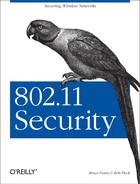Regardless of the underlying PHY used, the MAC is the same for all currently deployed 802.11 wireless technologies. The 802.11 MAC provides several functions: access to the wireless medium, joining and leaving a network, and security services.
Access to the wireless medium is controlled by a contention-based protocol called Carrier Sense Multiple Access with Collision Avoidance (CSMA/CA). This is a similar method to the one used in wired Ethernet. Like wired Ethernet, 802.11 devices are contending for the same physical transmission medium. If two or more devices are transmitting at the same time, their signals collide and it is impossible for the receiving station to discern the one signal from the other. CSMA/CA provides a way for 802.11 devices to probe the medium to see if it is in use and then lock the medium while they transmit.
Since 802.11 wireless networks use a shared medium, the more devices that are trying to access it, the lower the effective throughput will be. This is similar to standard wired Ethernet. When an 802.11 device is transmitting, no other device in the network may transmit data. If there are multiple devices trying to send large amounts of data, there will be heavy contention for the airwaves. This congestion gets worse as more machines are added or more data is being transmitted.
The core unit of an 802.11 network is called a Basic Service Set (BSS). A BSS consists of a central access point (AP) and client stations. The AP coordinates all of the activities within the BSS. Due to this centralized control, BSS networks are sometimes called infrastructure networks. A BSS is identified by a service-set identifier (SSID). This can generally be thought of as the name of the wireless network.
A station that wants to join a BSS network will look for available APs. Some APs send beacons to inform stations of the AP’s existence. Other APs suppress beacons for security reasons. Without a beacon, a station must know the SSID of the AP a priori.
Once a station has identified a BSS it wants to join, it sends an association request to the AP. The station and AP go through a handshake process that exchanges vital information regarding the network as well as any authentication that may be needed in order for the client to join the network. For more information on the authentication process, see Section 1.6.2 later in this chapter.
Once the station has associated itself with the AP, it has officially joined the wireless network. From this point forward, the AP intermediates network communication with the station. The AP may relay traffic between two stations that are communicating with each other. The AP may also act as a bridge between the 802.11 network and a wired network such an 802.3 network.
When a station is done using the wireless network, it should disassociate from the AP. This allows the AP to clear up any internal memory it may have been using for the associated client. However, since stations may leave the network without disassociating (i.e., if a user roams out of range of the AP), APs will time out associations that haven’t been used for a period of time.
In order to facilitate networks that may not have an AP to coordinate communications, an independent BSS (IBSS) may be formed between two stations. An IBSS network (sometimes called ad-hoc) allows two stations to associate directly with each other without an AP. While IBSS networks do not scale like BSS networks, they can be very useful for short-lived networks such as a head-to-head network game between two friends.
